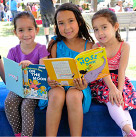Instilling the value of gratitude in children is always important, but as we enter the “giving season,” now is a great opportunity to help young ones understand this concept.
Learning the art of thankfulness can start with appreciating people, things, and experiences. We can show children how and help them establish their own gratitude practice to cultivate a genuine appreciation of the world around them. Studies show that practicing gratitude early on has positive outcomes, including nurturing characteristics of kindness and happiness.
Like this blog explains, gratitude is all about recognizing and expressing the warm feelings of joy and appreciation that come when a person is kind to them, when they receive something, or even enjoying a beautiful day.
Research by The Greater Good Science Center at the University of California, Berkeley found that teaching gratitude to children produces a range of outcomes and generally, kids are more kind. Here are some ways to promote gratitude with children at home:
Joyful Learning
Engage children in joyful learning experiences to impart this valuable lesson effectively. The research shows that joyful learning can inspire lifelong learning. When children enjoy what they are learning, it allows them to feel a stress-free sense of accomplishment.
Gratitude Prompts for Kids
Whether it’s a gratitude journal for older children or gratitude art for all ages, this feeling can be expressed and appreciated in many different ways. Try prompting your child at the dinner table to think of what they are grateful for and either ask them to write it down or record it for them. With art, children can show with colors and shapes how an experience of gratitude made them feel – when words fail, creativity can be used to express the feelings.
Finding Gratitude in Abstract Ideas
You can also help your kids understand important values like Diversity and Inclusion. These concepts can make them even better at showing gratitude to their peers.
Teach children that the things we take for granted – like food and shelter – are also reasons to be grateful. The friendship of their siblings and love from their parents and grandparents is another reason to express gratitude.
Does your child love his or her child care provider? Encourage them to write a note of thanks or create gratitude art for their early educator.
Share Your Own Gratitude
When prompting a child to express their gratitude, it’s important to teach by doing. Offer up some of your own reasons for being grateful and explain. Try it at your next holiday get together – ask everyone at the table to go around and say one thing that makes them feel gratitude. The dinner will taste even better knowing what each person appreciates.


